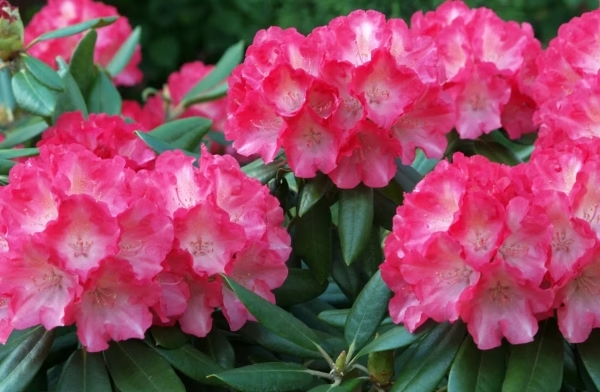
Azalea
Botanical Name
:
Rhododendron spp.
Plant Type
:
Flowering deciduous or evergreen shrub
Seasons
:
Plant in early spring or fall; Blooms from early spring to early summer (some varieties rebloom in fall)
Sun Level
:
Partial shade to filtered sunlight; prefers morning sun (at least 3 hours) and afternoon shade
Ideal Soil Temperature for Planting
:
Optimal range of 60–75°F (15–24°C)
Soil Type
:
Well-draining, acidic, organically rich soil
Hardiness Zones
:
3–10 (USDA)
Germination
:
Seeds germinate in 2–6 weeks in moist, well-aerated conditions
P.H. Level
:
Acidic (4.5–6.0)
Water/Irrigation
:
Keep soil consistently moist but not waterlogged; requires more water during blooming season
Fertilization
:
Use an acid-loving plant fertilizer (e.g., 10-5-4) in early spring and after blooming
Habit
:
Compact, mounding, and spreading
Propagation
:
Semi-hardwood cuttings in summer, layering, division, seeds (less commonly used)
Final Plant Height
:
6–10 ft
Spread
:
5–8 ft
Flowers
:
Pink, red, white, purple, orange, or yellow, often trumpet-shaped
Attracts
:
Bees, butterflies, and hummingbirds
Uses
:
Foundation planting, woodland gardens, container gardening, hedges, and specimen plants
Companions
:
Camellia, ferns, hostas, Japanese maple, hydrangeas
Pruning
:
Light pruning after flowering to shape; remove dead branches in late winter
Toxicity
:
Highly toxic to humans and pets if ingested (contains grayanotoxins)
Pests
:
Aphids, mites, borers, lace bugs, caterpillars, leafhoppers, mealybugs, nematodes, scale, thrips, and whiteflies
Diseases
:
Powdery mildew, root rot, petal blight, leaf gall
Fun Fact
:
Azaleas symbolize temperance and passion in different cultures, and in Japan, they are celebrated during the annual Azalea Festival (Tsutsuji Matsuri)
Botanical Name
:
Rhododendron spp.
Plant Type
:
Flowering deciduous or evergreen shrub
Seasons
:
Plant in early spring or fall; Blooms from early spring to early summer (some varieties rebloom in fall)
Sun Level
:
Partial shade to filtered sunlight; prefers morning sun (at least 3 hours) and afternoon shade
Ideal Soil Temperature for Planting
:
Optimal range of 60–75°F (15–24°C)
Soil Type
:
Well-draining, acidic, organically rich soil
Hardiness Zones
:
3–10 (USDA)
Germination
:
Seeds germinate in 2–6 weeks in moist, well-aerated conditions
P.H. Level
:
Acidic (4.5–6.0)
Water/Irrigation
:
Keep soil consistently moist but not waterlogged; requires more water during blooming season
Fertilization
:
Use an acid-loving plant fertilizer (e.g., 10-5-4) in early spring and after blooming
Habit
:
Compact, mounding, and spreading
Propagation
:
Semi-hardwood cuttings in summer, layering, division, seeds (less commonly used)
Final Plant Height
:
6–10 ft
Spread
:
5–8 ft
Flowers
:
Pink, red, white, purple, orange, or yellow, often trumpet-shaped
Attracts
:
Bees, butterflies, and hummingbirds
Uses
:
Foundation planting, woodland gardens, container gardening, hedges, and specimen plants
Companions
:
Camellia, ferns, hostas, Japanese maple, hydrangeas
Pruning
:
Light pruning after flowering to shape; remove dead branches in late winter
Toxicity
:
Highly toxic to humans and pets if ingested (contains grayanotoxins)
Pests
:
Aphids, mites, borers, lace bugs, caterpillars, leafhoppers, mealybugs, nematodes, scale, thrips, and whiteflies
Diseases
:
Powdery mildew, root rot, petal blight, leaf gall
Fun Fact
:
Azaleas symbolize temperance and passion in different cultures, and in Japan, they are celebrated during the annual Azalea Festival (Tsutsuji Matsuri)
Written by Nondiah Khalayi – https://www.linkedin.com/in/nondiah-khalayi/

